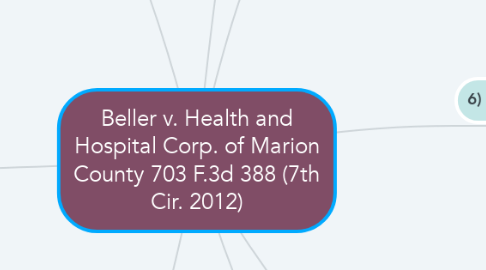
1. 1) Facts
1.1. Involved Parties
1.1.1. Plaintiff - Melissa Welch & Joshua Welch
1.1.2. Defendant - Health and Hospital Corporation of Marion County, Indiana - d.b.a. Wishard Memorial Hospital.
1.1.3. Rovner - Circuit Judge deciding on the case.
1.2. Melissa Welch was 34 weeks pregnant and called 911. When a Wishard Memorial Hospital ambulance arrived, the paramedics assessed her and determined her water broke and she had a prolapsed umbilical cord.
1.3. They tried to relieve the pressure on umbilical cord and were unsuccessful, so they transported her to St. Francis Beech Grove emergency room.
1.4. The St. Francis Beech Grove emergency room did not have an obstetrics facility, so they transferred her to St. Francis Hospital South for delivery.
1.5. Joshua was delivered by C-Section, but suffered hypoxia, lack of oxygen, resulting in severe brain damage.
1.6. The plaintiffs allege that Wishard (the hospital owning the ambulance) violated EMTALA by transferring them to Beech Grove, rather than delivering the baby in the ambulance.
1.7. The district court sided with Wishard, the defendant, and the plaintiff appealed.
2. 2) Issue
2.1. The issue in this case is the definition of "come to the emergency room."
2.1.1. Was the Wishard ambulance in this case considered the emergency room or were they "passing off" the patient?
2.1.2. There are 2 definitions of "coming to the emergency room." The original in 2001 and a 2003 amendment.
2.2. The 2001 definition favored the plaintiff's case and the 2003 definition favored the defendant. The question in this case if if the 2003 definition could be applied retroactively.
3. 3) Rule of Law
3.1. The 2001 definition of "come to the emergency room" is that the individual is on the hospital property.
3.1.1. Property of the hospital in this case includes ambulances owned and operated by the hospital, even if not on hospital grounds.
3.2. The 2003 definition amended this to specify how the ambulance is operating.
3.2.1. If the ambulance is operated under the community wide emergency medical service protocols that direct it to take the patient to another hospital than the hospital that owns the ambulance, the ambulance does not count as the same extension of the emergency room.
3.3. The question is whether this amendment was a new change to the law or simply clarifying a confusing or unsettled part of the 2001 definition.
3.3.1. The rule can be used retroactively, if it determined that it is a clarification of the previous definition, rather than changing the law.
3.3.2. The agency can deem it is a clarification unless the prior interpretation of the regulation was blatantly inconsistent with the later one.
4. 4) Ananlysis/Application
4.1. The district court decided that the 2003 amendment was a clarification of the 2001 definition and granted summary judgement for the defendant. The plaintiff challenged this on appeal with:
4.1.1. 1) They argue that it is not clear that the DHHS characterized this amendment to be a clarifcation.
4.1.1.1. The DHHS stated that the changes were clearly clarifications.
4.1.1.1.1. The title stated "Clarifying Policies Related to the Responsibilities of Medicare-Participating Hospitals in Treating Individuals with Emergency Medical Conditions.
4.1.1.1.2. The final rule stated that the change was to clarify the changes, ensure proper and consistent application of the policy, and to avoid misunderstanding of EMTALA requirements by all involved parties.
4.1.2. 2) Even if the DHHS did characterize this as a clarification, the district court failed to give fair attention to the fact of if this amendment was a true change or clarification.
4.1.2.1. The original law states that the ambulance must be owned AND OPERATED BY a hospital. The plaintiffs' complaint was solely on the ownership of the hospital, even though it was operating under different leadership.
4.1.2.2. The case states that the court examined this and ruled that there are no inconsistencies between the 2001 and 2003 definitions, affirming the decision of the district court.
4.1.2.2.1. The statement of this shows that the court examined all of the literature and decisions behind this in their decision making process.
5. 5) Conclusion
5.1. The court affirmed the decision in favor of the the defendant.
5.2. They decided that there were no inconsistencies between the 2001 and 2003 definitions. The patient still would be considered to have come to the hospital if in an ambulance owned and operated by the hospital.
6. 6) Impact
6.1. Glenn DRIVER, Demiko D. McCaster, Rosamar Mallari, Joyce A. Britton and Michael H. Hicks, on behalf of themselves and all other persons similarly situated, known and unknown, Plaintiffs, v. APPLEILLINOIS, LLC d/b/a Applebee's Neighborhood Grill & Bar, W. Curtis Smith, James Borke, J. Timothy Brugh, Archie Iodice, et al., Defendants. 917 F.Supp.2d 793
6.1.1. Employees brought a class action law suit against Applebee's for alleged violations agains the Illinois Minimum Wage Law and Fair Labor Standards Act.
6.1.2. Beller v. Health and Hosp. Corp. was refernced to decide whether 29. C.F.R. 531.59(b) applies retroactively and is a clarification of an existing law or a change to the law.
6.1.3. The court ruled in favor of the plaintiffs on part and ruled in favor of the defendants on part.
6.2. HCA Health Services of Tennessee, Inc., et al. v. Bluecross Blueshield of Tennessee, Inc. 2016 WL 3357180
6.2.1. The hospitals brought action agains BCBS for breach of "implied in law" contract and was trying to recover costs for emergency services provided to insured patients.
6.2.2. Beller v. Health and Hospital Corp. was referenced to cite EMTALA and its information pertaining to the hospitals requirement of assessing patients for emergency medical conditions prior to transferring a patient to another facility.
6.2.3. The court ruled partially in favor of both parties.

